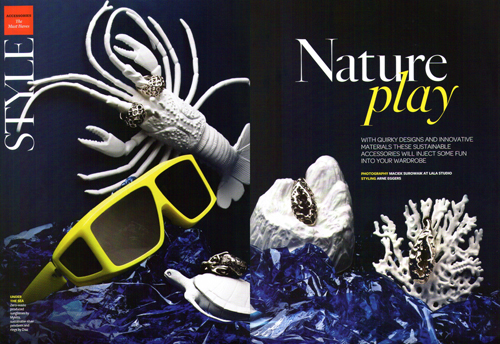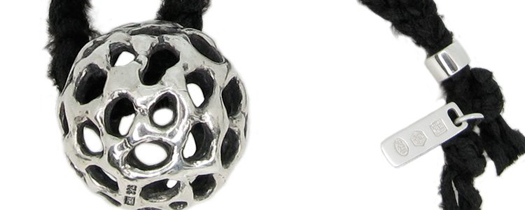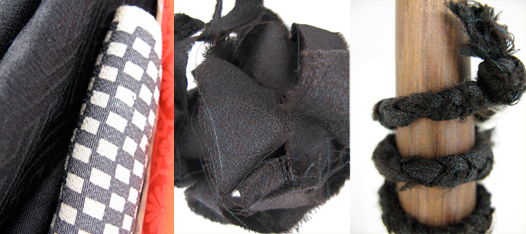RE Experiment – The Molten Ring
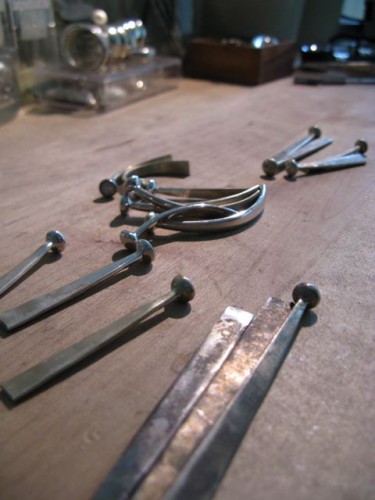 The possibilities are endless as we play around with more designs for the ‘up-cycled’ RE series. Once again, using old silver bangles, this time we experimented by putting several pieces together, tying them with wire and using an interesting technique of fusing rather than soldering. The aim was for more unpredictable formations, and this was achieved by keeping the temperature high enough so that the joints of the pieces melt and fuse together. The magic touch is added when heating it further actually makes the metal molten in places. Temperature control is key to prevent total melting that would simply deform the ring. It’s a lava-inspired feeling. The result is pretty awesome! It’s chunky-biomorphic and edgy all rolled in one.
The possibilities are endless as we play around with more designs for the ‘up-cycled’ RE series. Once again, using old silver bangles, this time we experimented by putting several pieces together, tying them with wire and using an interesting technique of fusing rather than soldering. The aim was for more unpredictable formations, and this was achieved by keeping the temperature high enough so that the joints of the pieces melt and fuse together. The magic touch is added when heating it further actually makes the metal molten in places. Temperature control is key to prevent total melting that would simply deform the ring. It’s a lava-inspired feeling. The result is pretty awesome! It’s chunky-biomorphic and edgy all rolled in one.
Vintage Kimono Pouches
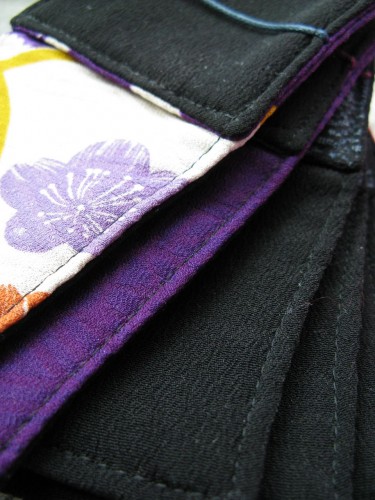 All DIAZ Jewelry now comes packaged in a gorgeous silk kimono pouch that fits snuggly in our gift box. Of course, in keeping with our packaging philosophy, the silk used is recycled remnant fabric and the pouches are hand sewn in Japan. We love that each pouch is unique and no two are alike.
All DIAZ Jewelry now comes packaged in a gorgeous silk kimono pouch that fits snuggly in our gift box. Of course, in keeping with our packaging philosophy, the silk used is recycled remnant fabric and the pouches are hand sewn in Japan. We love that each pouch is unique and no two are alike.
Simple…
Beautiful…
Functional….
Which comes first, the poop or the paper?
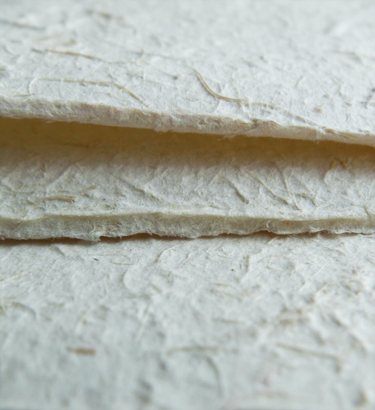 In our never-ending quest to find more sustainable ways to package our jewelry, we recently came across a wonderful substitute for paper packaging made from pulpwood.
In our never-ending quest to find more sustainable ways to package our jewelry, we recently came across a wonderful substitute for paper packaging made from pulpwood.
We discovered paper made out of elephant poop.
Yep, ELEPHANT POOP!
We immediately fell in love with the gorgeously textured paper and have used it for packaging as well as for displaying our pieces at exhibitions.
As everyone naturally does, we know you’re wondering, so we’ll tell you not to worry, it is completely and utterly odorless. You’d never guess! Here’s an explanation on how it can be done from POOPOOPAPER™, a cool online store specializing in all sorts of paper made from all sorts of animal poop.
“Here’s the scoop: these fiber-eating animals eat lots of grass and vegetation everyday and they poop almost as much. Since the digestive systems of these specific animals don’t really break down the vegetation all that well, their poop has plenty of fiber even after their meal is consumed. Knowing that fibers are the base material used in making pulp for paper production (albeit tree fibers typically), we figured there was a high probability that making pulp and quality paper from poop was not only achievable but that the case for poop as an alternative fiber source to tree-based pulp was a compelling one!”
PLAYFULLY OUTRAGEOUS WITH A SERIOUS UNDERLYING MESSAGE OF SUSTAINABILITY!
DIAZ in Hong Kong Tatler
What an honor to be included in the annual Green Issue of the Hong Kong Tatler!
We’re featured alongside other fabulous, quirky and innovative sustainable creations in the ‘Style’ section in a beautifully styled double-page spread.
The featured pieces are from the SOL Collections: the Wabi, Sabi and Iwa Rock pendants, and the Figroot Black and Figroot White rings, all from the Bonsai Series.
Life After Diamonds
Life After Diamonds from Sheryle Carlson on Vimeo.
Just found a great video worth sharing!
We’ve always stood firm on our belief that along with the price tag attached to them, the true cost of diamonds – that is, the environmental and humanitarian costs are far too high. Even though much has been said and documented about conflict diamonds, many people are still unclear about (or unwilling to accept) the fact that there are problems associated with diamonds beyond their association with war and terrorists.
Three years after we set out on a mission to raise awareness and support efforts to offset the damaging effects of diamond mining on local communities and the environment through mine reclamation and organic agriculture projects in Bandafaie, Sierra Leone, we’re thrilled to have stumbled across this fantastic documentary video created by OneSky volunteers Larissa Stendie and Sheryle Carlson. While it graphically documents the suffering of the miners and their community as well as the shocking devastation to the landscape, you’ll also get a first hand glimpse at the positive impact the reclamation/farming project had on the environment and people. ‘Life After Diamonds’ is a must-see for all skeptics and believers alike – to confirm what all the fuss is about with diamonds; to realize that diamond mining practices as they exist must be reconsidered on a more holistic level, whether on an artisanal or industrial level, because either way, the repercussions are enormous.
This short video proves that everyone has a choice.
There really is life after diamonds for mining communities and consumers alike, but first, there must be realization that there is something not quite right, and then the will to make it right.
Please watch.
Enjoying a Renaissance
The first time I saw the finished Figroot Dome pendant, it reminded me of obidome ornaments – small brooches worn threaded onto the obijime that make a charming decoration on the front of the obi of a kimono. It is said that they were originally worn and made popular by the geisha…
Combining the Figroot Dome pendant with kimono by incorporating reclaimed kimono silk into our collection was perfect. In line with our endless quest for beautiful sustainable materials, it was simply fitting for DIAZ to revive the gorgeous remnant fabric into a unique piece of contemporary jewelry.
The fabric we used for the collection ranges in age from approximately a century to 50 years old and originates from the south-western region of Japan, in and around Kyoto. We’ve hand-braided it to give a rustic, frayed look to the cord, and love that each one is unique and one-of-a-kind…
I’ve always been fascinated with kimonos. My Japanese heritage would probably explain that, but I never actually saw my mother nor my grandmother ever wearing one. As a child, I was captivated by the black and white images of kimono clad ladies in old family portraits and drawn to stories of geisha – images of a lost golden age steeped in rich culture and tradition.
While some kimonos were surprisingly casual and simple, others reserved for formal occasions were elaborately detailed, depicting impressive images of auspicious or celebratory symbolism, almost always including elements from nature and the seasons. More than a picture, the intricate designs spoke stories and read like poems without words. It wasn’t until I’d met my mother-in-law, a seamstress and collector of antique kimono and obi that my love for the magical silk fabric was confirmed. Sitting with her in her studio, blissfully surrounded by piles upon piles of neatly cut strips of kimono silk, hours would melt away as I listened, mesmerized by the stories each set of silken fabric told… This one, over a hundred years old belonged to her great grandmother; this one, a kimono worn by a bride on her wedding day half a century ago; yet another one, an especially pretty one, was custom made for a girl to celebrate her coming of age… the colorful stories matched in depth and beauty with the fabric itself.
Amid the deliciously rich hues of gold, green, red, purple and pink, the sleek black kimonos would always catch my eye. Although all seemingly similar, upon careful inspection in just the right light, I could trace each thread of silk and see a myriad of colors woven into the pure black threads. There are subtle differences in shades and woven patterns, a subtlety so delicate and deliberately subdued – so Japanese! For this reason, the black kimono fabrics are my favorite. Although most would pick the colorful, patterned kimono or obi to represent and demonstrate the beauty of kimono, I would definitely choose the sultry blacks… as I have for Figroot Dome.
- Salina
No-sweat Workshop
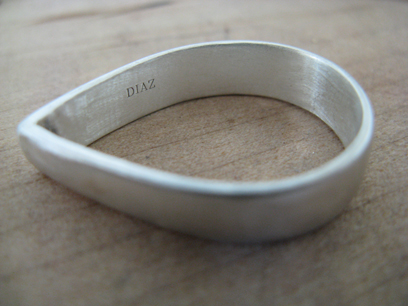 It’s been a busy but fun-filled couple of weeks hand-crafting the limited edition RE series in the workshop. I’m told what makes making the RE jewelry such a joy is the ‘no-sweat’ approach – that each piece is cut from remnants of a cuff bangle and then hand filed, shaped, hammered and polished with practically no use of heat or machinery.
It’s been a busy but fun-filled couple of weeks hand-crafting the limited edition RE series in the workshop. I’m told what makes making the RE jewelry such a joy is the ‘no-sweat’ approach – that each piece is cut from remnants of a cuff bangle and then hand filed, shaped, hammered and polished with practically no use of heat or machinery.
I think the real charm of it is the fact that although similar in origin, each one ends up being unique in texture, shape and symmetry, and no two ever look exactly alike, giving each a character of its own – just like family! Embracing differences and promoting uniqueness, both in individuals and in jewelry is just the way we like it – no pressure, just go with the flow…
That’s just what we love about this ring, the RE0005. We don’t recall there ever being a rule that said a ring can’t be any other shape but round or that it can’t double as a pendant that doesn’t look like a ring. It’s sleek chic as a pendant on a chain or leather cord, and is super comfortable worn as a ring, alone or stacked, sideways or pointing straight up…
The first batch of rings and pendants have been shipped out of our workshop and are stocked at ECOLS and the TDC Design Gallery (available mid-June) in Hong Kong. They’ll also be available at US-based online jewelry store, Sulusso.com later this summer making RE available to everyone – where ever you may be.
We hope to create more unique additions to the RE family soon as well as expand our brood of awesome retailers.
- Hope you enjoy the current collection as much as we did putting it together…
RE @ ECOLS – Grand Opening May 27

We’re so excited to announce the May 27th grand opening of ECOLS at The ONE, Tsim Sha Tsui where our up-cycled RE series will be available for the first time ever in Hong Kong.
ECOLS is the first ECO lifestyle store in Hong Kong, offering a great selection of eco art, eco lifestyle products and fashion accessories.
The upcycled RE rings and pendants are created out of ‘flawed’ silver bangles salvaged from the workshop, giving birth to a completely different unique, handmade, one-of-a-kind jewelry. In addition to not using ‘virgin’ silver, by manually hammering and shaping the rings and pendants instead of casting recycled silver, the energy consuming processes have been avoided, leaving no footprint behind.
The RE series is fun and beautiful in every way, and they make an awesome gift that shows you really care…
Check out the ECOLS website for more information about their products and eco-ethos, and look for the fantastic new shop on Level 6, The ONE – next to Caffe HABITU…
Be sure to check out the RE series while you’re there!
Restless wanderers between the realms of art and design…
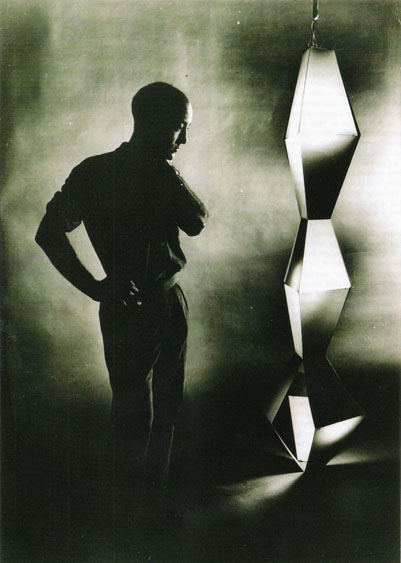 Modern yet totally traditional, Isamu Noguchi’s Akari lights were made popular way back in the 1950s. Lovely to look at and surprisingly robust, the Akari lights not only fuse Isamu Noguchi’s Japanese and American influences, but art and design, craftsmanship and industry. For the shades, Noguchi used the silky Mino paper that had been made in a nearby village from locally grown mulberry bark since the eighth century. He replaced the wire frames then commonly used in Japanese candlelit lanterns with more traditional bamboo – talk about great sustainable design!
Modern yet totally traditional, Isamu Noguchi’s Akari lights were made popular way back in the 1950s. Lovely to look at and surprisingly robust, the Akari lights not only fuse Isamu Noguchi’s Japanese and American influences, but art and design, craftsmanship and industry. For the shades, Noguchi used the silky Mino paper that had been made in a nearby village from locally grown mulberry bark since the eighth century. He replaced the wire frames then commonly used in Japanese candlelit lanterns with more traditional bamboo – talk about great sustainable design!
Some lamps were geometric, and others elaborately curved in the biomorphic style of 1950s furniture. Noguchi also enjoyed playing with the centuries-old shapes of the original candlelit lanterns. Like all great lighting designers (and unlike most artists who have become designers), Noguchi knew that the performance of his product, the quality of its light, was just as important as how it looked. His design was also supremely practical. The shade was so pliable that it could be collapsed and packed flat in a box for export. The Mino paper was not only tough, but acquired an endearing patina with age.
Noguchi called the Akari “restless wanderers between the realms of art and design.” They were, and they wandered equally restlessly – yet effectively – between craft and industry, East and West, with successful forays into economic regeneration and sustainability. Not bad for a light.
And for jewelry? We can’t help but see a parallel between Noguchi and our very own designer, Takashi – through his sculptured nature-inspired designs, Takashi attempts to do for contemporary jewelry what Noguchi did for the light.
“Green is the New Black” – DIAZ Interview in Horizon Magazine
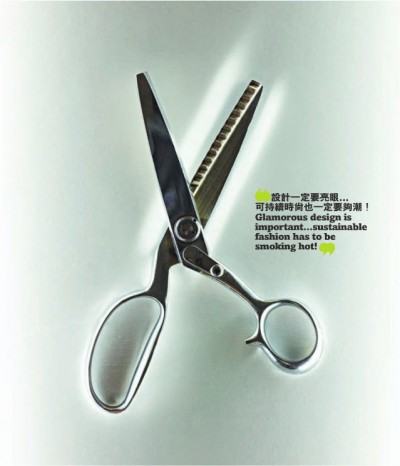 Check out the awesome article in the March 2011 issue of Horizon Magazine entitled “Green is the New Black” by journalist writer and DIAZ jewelry wearer Helen Dalley.
Check out the awesome article in the March 2011 issue of Horizon Magazine entitled “Green is the New Black” by journalist writer and DIAZ jewelry wearer Helen Dalley.
“Forget unflattering hemp skirts and kitschy ethical jewellery; eco fashion is evolving into something way cooler as a wave of environmentally conscious style pioneers steer green design into more glamourous territory in Hong Kong”.
The article features excerpts from interviews with local pioneers, including our very own Creative Director, Salina on global trends in sustainable fashion and it’s influences in Hong Kong.
The latest
- RE Experiment – The Molten Ring
- Vintage Kimono Pouches
- The DIAZ Travel Diaries – HAWAII
- DIAZ in SilverStyles Magazine
- The DIAZ Travel Diaries – KYOTO
- Which comes first, the poop or the paper?
- The DIAZ Travel Diaries – ANGKOR WAT
- ‘Artisans d’Angkor’
- DIAZ in Post Magazine – Behind the Label
- Quote of the day
Categories
- Announcements (10)
- Designs (13)
- Events (2)
- News (8)
- Philanthropy (5)
- Philosophy (2)
- Press (5)
- Quote of the day (1)
- Sustainability (15)
- Thoughts (9)
- Travel (4)
- Uncategorized (1)
Archives

